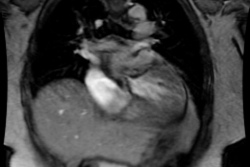Transposition Complexes/ Double outlet right ventricle:
Double outlet ventricle encompasses a wide spectrum of congenital heart abnormalities [1]. The 50% rule is applied and an artery is considered to be connected to a ventricle when more than half of it's valve is connected to that ventricle [1]. In more than 50% of patients with a double outlet ventricle, both the ascending aorta and pulmonary artery arise from the right ventricle [1]. Double outlet right ventricle is associated with a VSD in 100% of cases and about half to three-quarters of the affected patients will also have some degree of pulmonic stenosis or atresia [1,2]. A PDA may also occur.(1) Double Outlet Right Ventricle: (DORV Type I) In this form of DORV the aorta and pulmonary artery both arise from the morphologic RV (anterior). The vessels tend not to be aligned and therefore the cardiac waist is not as narrow. There is usually a muscular VSD. The LV may be normal in size, hypoplastic, or absent [2].
(2) Taussig-Bing Complex: (DORV Type II/Incomplete transposition) In this case, the aorta arises from RV (anterior), while the pulmonary artery overlies a high (membranous) ventricular septal defect and therefore takes its origin from both the RV & LV.
(3) Corrected Transposition: L-Transposition. The condition is characterized by one transposition and two inversions: 1- The great vessels are transposed (aorta anterior, pulmonary artery posterior); 2- The great vessels are inverted (aorta left, pulmonary artery on right) so that the aorta is anterior and to the left of the pulmonary artery (easily identified on cross sectional imaging); and 3- The ventricles are inverted (RV on left, LV on right). Therefore the LV (smooth) is below the RA and supplies the pulmonary circulation via the pulmonary artery. The pulmonary circulation in turn drains into the LA. The RV is below LA and supplies the systemic circulation via the aorta. Affected patients are not cyanotic, but frequently they do have other cardiac anomalies such as a perimembranous VSD (50%), anatomic tricuspid valve insufficiency, pulmonic stenosis (50%), or dextrocardia.
(4) Single Ventricle: A single ventricle is RARE. There is one large ventricle which most commonly has LV morphology. There is typically a very rudimentary RV and a large communicating VSD. Most patients have an associated transposition of the great vessels arising from the single chamber.
REFERENCES:
(1) Radiographics 2007; Leschka S, et al. Pre- and postoperative evaluation of congenital heart disease in children and adults with 64-section CT. 27: 829-846
(2) Radiographics 2010; Frank L, et al. Cardiovascular MR imaging of conotruncal anomalies. 30: 1069-1094





